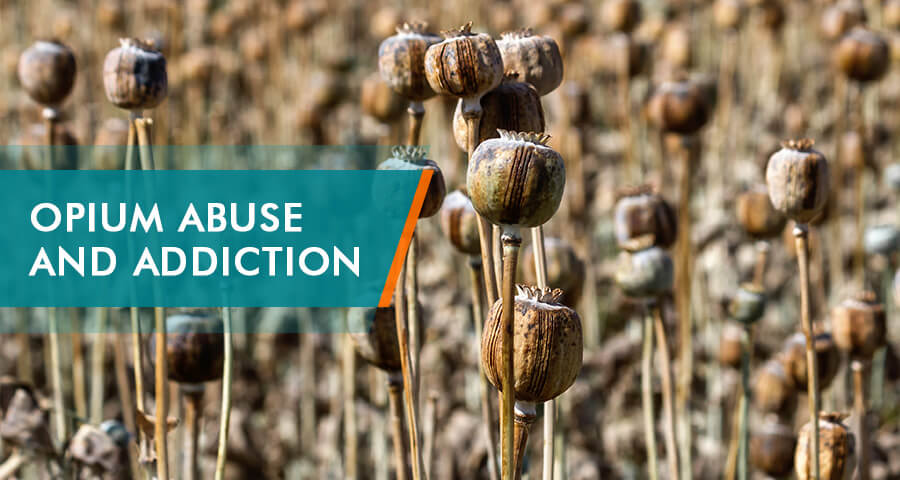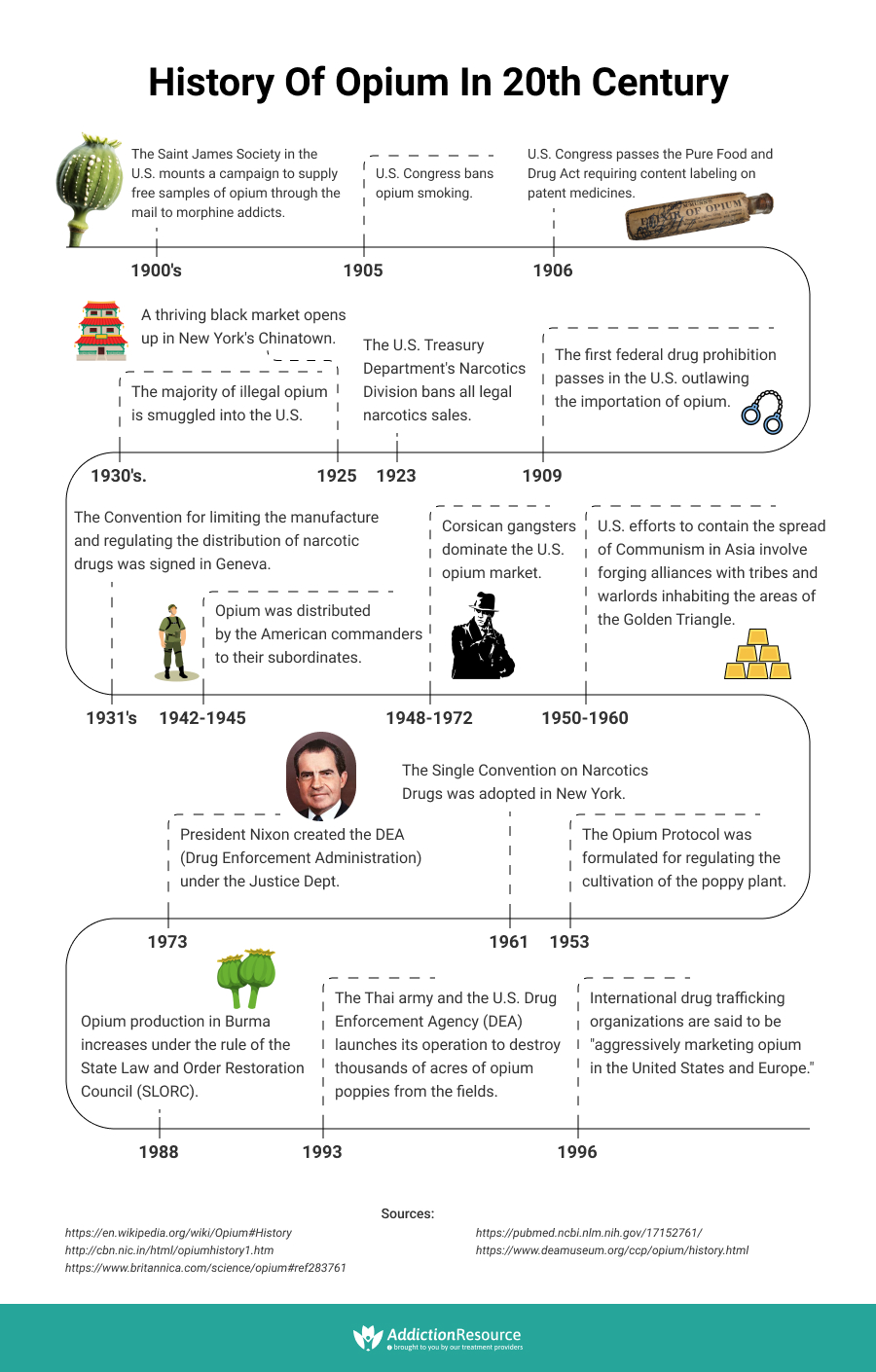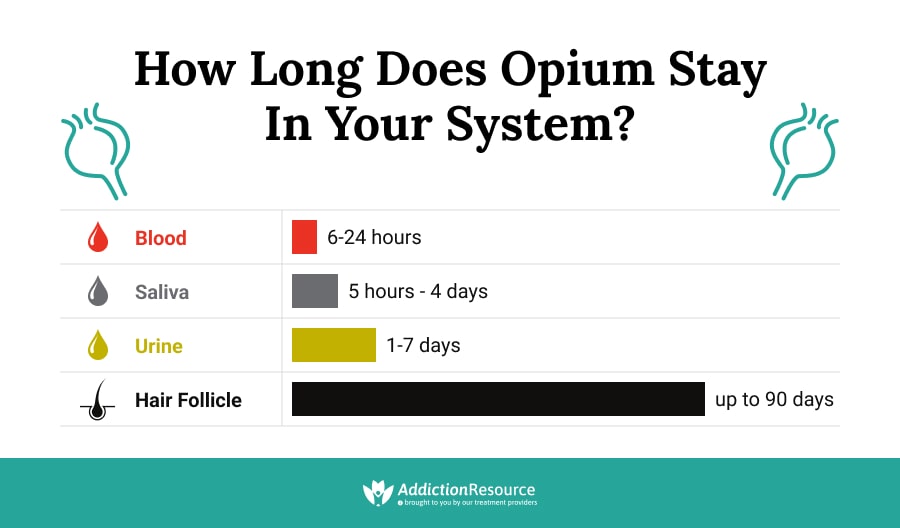
For millennia, opium has been used for pain during surgical procedures and using it too much is not good for the health and could lead to dependence. This may cause an individual not to be sure of their next step or even be frightened or confused, especially when it happens to them or a loved one. This could result in worrying about managing the symptoms or the stress of going through detox.
Table Of Contents:
This article will explain the history of Opium, signs, and symptoms of addiction, and successful treatment options.
What is Opium?
Opium is the name given to the milky latex that is obtained from the opium poppy Papaver somniferum. This narcotic is gotten from the seed pods of the poppy plant.
It is a narcotic because it produces narcosis-like feelings and has a possibility to lead to addiction after usage. Also, it contains active alkaloids like:
More About Opioids:

The milky latex obtained from the poppy contains about 12% of morphine, the opiate used to synthesize opioids like heroin and codeine.
In many Asian nations, as well as in the Middle East region, after tobacco, Opium is the second most commonly abused substance.
What Does Opium Look Like?
The opium plant is an annual plant that can grow up to 3 to 16 feet (almost 5 meters) tall. Its foliage is lobed, but most times they are toothed. They are silver-green. The plant is also a flowering plant, and when it bears flowers, they are sometimes blue-purple or white. These flowers are about four to five inches wide. Some varieties or strains of the plant have red flowers and are used as ornamentals for gardens, not for treating pain. So, what does Opium look like? Opium is a sticky dark-brown gum with a strong odor. It can also be a different form, like:
- Solid
- Liquid
- Powder
Is Opium Illegal?
The opium drug is globally and strictly regulated under international law and policy.
All countries that produce it are to be signatories to the United Nations Single Convention on Narcotics, which was set up in 1961. This convention is saddled with the responsibility of controlling and supervising all the stages of production and growth.
The production of these substances occurs in three main regions. But the use is not limited to the three regions.
- Southeast Asia
- Southwest Asia
- Latin America

It also manages the import and export of other narcotic materials.
So if the user is wondering if it is illegal, then the answer to this question is yes. It is illegal, and a schedule II drug in the U.S. Controlled Substance Act. In the U.S. efforts to reduce its availability have met some challenges.
History of Opium
The main and only source of opium is the opium poppy. Popular belief is that it evolved from a wild strain, the Papaver setigerum, which was found in the coastal area of the Mediterranean Sea, although many do not agree with this. Over the years, it has been cultivated, until a species of the opium plant, commonly known as somniferum evolved.
But today, the Papaver somniferum is the only Papaver that produces the sticky substance of interest.
Opium History Timeline
A brief historical timeline of the use and spread of the plant, from ancient Sumeria to the United States. This timeline spans from 4000 BC till about the 19th century.
4000 BC
The history of opium could have been said to begin here, in ancient Sumeria. The poppy plant symbol in ancient Sumeria is “hul”, which translates to “Joy” and “gil”, which translates to “plants”.
2600 BC
Almost 4000 years ago, the plant was known in Europe, almost in the Neolithic age. This knowledge was scientifically backed by fossil remains of poppy seed cakes and pods found in the Swiss Lake dwellings.
1600 BC
Archaeologists made a discovery that traces as far back as 1600 BC, when they discovered flasks that took the form of poppy capsules. The ball that bulges under the plants’ flower.
450 BC
The opium drug was not just known to the Greeks alone. It was also consumed by the Egyptians in large quantities as well. To add to this information, Hippocrates, the father of medicine who lived at that time, recorded the importance of drinking juice of the mixture of nettle seeds and poppy seeds for health.
220 AD
Although studies claim it was till the 7th century that it got to China, ancient Chinese records proved that Hua To, the Chinese surgeon of the ancient Chinese three kingdoms used this substance for his patients. He used them on his patients, in combination with cannabis, before carrying out serious surgical procedures on them.
7th century
Opioids finally reached China, through the efforts of Arab travelers, who advocated its medical uses.
17th century
This century witnessed widespread use in China. It was mostly associated with the introduction of tobacco by the Dutch from Java.
19th century
The century has seen a lot of scientific breakthroughs regarding the plant.
In 1803, one of the potent and principal alkaloids was described and isolated by a German pharmacist, Serturner. He named the alkaloid Morphium, which he derived from Morpheus, the god of dreams in Greek mythology.
In 1832 another alkaloid, codeine, was discovered. It was also closely related to the invention of syringes.
In 1848, another alkaloid, an opioid named papaverine, was discovered.
In 1850, a decrease in the use of the plants’ crude form was associated by an accompanying increase in the medical use of the pure form of the plants’ alkaloids.
Also, in this century, its preparation became widely spread in the United States, and it was used extensively for soldiers during the Civil War. This inevitably caused an addiction that was then known as the Army’s disease or soldiers’ disease. It also led to the scientific search for potent painkillers that were not addictive.
In the 1870s, the search for supposedly non-addictive substitutes for morphine came to an end as one was developed by chemists. The Bayer Pharmaceutical company of Germany was the first to produce these drugs in large quantities, with the brand name of heroin. The plant was native to what’s now known as Turkey. It was also common in Greece and ancient Sumeria. From there, it spread to India and China, then Europe and America.
In the 20th century, there was a decline in the use of crude opium, because of the applying of more powerful opioids. The century also witnessed curtailing the usage of opiates, which led to an underground rise of illicit trades.

Is Opium Addictive?
Yes, it is addictive. Under the Northern Territory Legislation Misuse of drugs act, it is a schedule II drug. This is to say that it has a very high potential to be abused, resulting in addiction, one of the effects of opioids use.
When individuals go through this abuse, it causes their brains to change, and they develop increased tolerance to the drug. They begin using the substances more frequently or in increased amounts to meet this tolerance and satisfy their inner cravings.
Not only is opium addictive, but it’s also not good for the health, and its frequent use can lead to an increase in the chances of an overdose. Addiction leads to physical and psychological changes, many of which can lead to long-term health complications. And since the active alkaloid binds to the opiate receptors in the brain, long cases of opium abuse could lead to the loss of cognitive ability leading to struggling with fulfilling responsibilities in school, work, or home.

Opium Addiction Signs and Symptoms
In the worst cases, it can result in overdose and/or eventually death. That’s why there are policies regarding its use. To avoid this, it is necessary to understand the dangers of this drug and to know the signs and symptoms to search for.
The signs and symptoms resulting from being addicted can cause physical and psychological changes. Almost rarely, people with dependence problems can hide theirs, but sometimes they can be spotted in a person’s mood or appearance.
Physical Signs and Symptoms of Opium Addiction
Addiction to this substance can lead to mild or severe health problems, with long-term effects. The longer individuals use this substance for pain, the more likely they are to experience these health issues.
The common physical symptoms associated with abuse are (These are the mild symptoms, severe cases present different symptoms):
- Mental fog
- Dry mouth
- Constipation
- Dilated pupils
- Respiratory distress
- Lethargy
- Excessive sleeping
- Difficulty sleeping
In severe cases, the effects of opioids may cause:
- Low blood pressure
- Redness of the skin
- Nausea
- Fatigue
Psychological Signs and Symptoms of Opium Addiction
When people become dependent, they isolate themselves and even lose interest and productivity.
The common psychological symptoms associated with abuse are:
- Self-isolation
- Irritability
- Easy loss of concentration
- Mood swings
- Trouble accomplishing everyday tasks
- Change in appearance
- Engaging in risky behaviors
- Volatile behaviors
- Drug hoarding
- Low productivity level
- Anxiety
- Depression
- Suicidal thoughts
Psychology changes in this addiction can range from self-isolation to anxiety and depression. Dealing with the effects of abuse can lead to suicidal thoughts. And to ease the pain that accompanies this situation, some people may have an overdose, which may lead to death.

How Long Does Opium Stay In The System?
Although the number of hours this substance can stay in the system is dependent on a lot of factors, there are specific guidelines that can be used to decide it.
Urine Tests
This is the most common health test. Its mechanism of action is that it detects the by-products that are specific to this substance. As most of these end up in the urine. In the urine, it lasts for one to seven days.
Blood Tests
This is the most accurate test for detecting recent drug use. But it is very rigorous and expensive. That is why it’s not common. In blood, it lasts for six hours to 24 hours.
Saliva Tests
One of the less invasive forms of a medical check. The problem with this method of detecting opioids in the system is that its window for accuracy is small compared to urine testing. In saliva, it lasts for five hours to four days.
Hair Tests
This is in a way similar to urine testing. It can detect the by-products of substances months after use. In the hair, traces can last for about 90 days, and this is for all opioids.

Variables Affecting The Period of Opium Staying in Your System
There are a lot of factors deciding how long opium stays in the system. They include:
- User’s weight
- Amount taken
- Speed of metabolism
- Method of administration
- Method and dose of regular intake
- Users age
- Presence of other drugs in the system
- Gender
- Ethnicity
- Underlying medical conditions that affect the drug elimination process
There are so many reasons why a person undergoes opioid tests. It could be for employment or a workplace policy. But because of the effect, there is a need for close monitoring, especially in individuals with a known history of abuse.
Opium False Positive
For the confirmation method of the test, false-positive results are never produced. It is most common in initial drug screening for opium.
Could there be an opium false positive? Yes, especially after the injection of poppy seeds solution. This happens because the poppy seed contains the alkaloid morphine and to very small extent codeine. To completely verify the false-positive result, quantitating with mass spectroscopy is useful to clinicians.
Opium Addiction Treatment
Treating the dependence problems is necessary as it can save lives. In most cases, addicts are resistant to admit their problems. Withdrawal symptoms or cravings can be tormenting, as completely kicking it out of the system is very difficult. This is because it affects the brain receptors in the brain and affects the dopamine level. Hence, trying to quit or stay clean becomes tedious.
Whether very difficult or tedious, the surest way to save an addict is to help them search for the right treatment. Inpatient methadone centers are the best options when managing withdrawal and medical complications because they include other medications in the detoxification process.
Because of the controversies involved in using drugs to treat dependence, there are other drugs free and holistic methods that are more beneficial in managing people with a known case of opium abuse.
There are:
- Counseling
- Support groups
- Cognitive-behavioral therapy
- Intensive outpatient programs
- Faith-based programs
- Meditation
- Yoga
- Individual and group therapy
- Inpatient rehabilitation

Recovery from addiction requires rebuilding one’s physical and mental health as well as developing healthy relationships with others. Get help for them, and do it now, so their lives can get back to order as soon as possible.
Staying Clean
For individuals using this substance, there is an urgent need to look for addiction treatment or information about it. It’s a very delicate matter, especially when dealing with an addict. Nevertheless, when the individual uses the right approach, treatment through rehabilitation and recovering becomes more successful.
Because through this, the user will be able to avoid the problems of overdose and even improve their lives.
Hope Without Commitment
Find the best treatment options. Call our free and confidential helpline
Most private insurances accepted
Find Drug Rehabilitation Centers Near You Anywhere In the US
Addiction Resource team has compiled an extensive list of the top drug rehabilitation facilities around the country. Use our locator tool to find the best centers near you.
Page Sources
- Ahmadinejad M, Karimi-Aliabadi H, Dehghan M, Mangolian P, Tajoddini S. Higher Morbidity and Mortality in Trauma Intensive Care Unit Patients with Opium Addiction. Addict Health. 2021 Jan;13(1):1-8. doi: 10.22122/ahj.v13i1.284. PMID: 33995954; PMCID: PMC8080177
- Hamilton GR, Baskett TF. In the arms of Morpheus the development of morphine for postoperative pain relief. Can J Anaesth. 2000 Apr;47(4):367-74. doi: 10.1007/BF03020955. PMID: 10764185
- Kalant H. Opium revisited: a brief review of its nature, composition, non-medical use and relative risks. Addiction. 1997 Mar;92(3):267-77. PMID: 9219389
- Kłys M, Maciów-Głab M, Rojek S. Z dziejów opium [On the history of opium]. Arch Med Sadowej Kryminol. 2013 Jul-Sep;63(3):226-35. Polish. PMID: 24672899
- Mani, D., & Dhawan, S. (2014). Scientific basis of therapeutic uses of opium poppy (Papaver Somniferum) in Ayurveda. Acta horticulturae, 175-180
- Masoudkabir F, Sarrafzadegan N, Eisenberg MJ. Effects of opium consumption on cardiometabolic diseases. Nat Rev Cardiol. 2013 Dec;10(12):733-40. doi: 10.1038/nrcardio.2013.159. Epub 2013 Oct 22. PMID: 24145895
- Norn S, Kruse PR, Kruse E. Opiumsvalmuen og morfin gennem tiderne [History of opium poppy and morphine]. Dan Medicinhist Arbog. 2005;33:171-84. Danish. PMID: 17152761
- Presley CC, Lindsley CW. DARK Classics in Chemical Neuroscience: Opium, a Historical Perspective. ACS Chem Neurosci. 2018 Oct 17;9(10):2503-2518. doi: 10.1021/acschemneuro.8b00459. Epub 2018 Oct 8. PMID: 30247870


 Reviewed by:
Reviewed by:  Written by:
Written by: 


 FindTreatment.gov
FindTreatment.gov